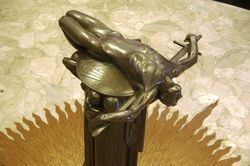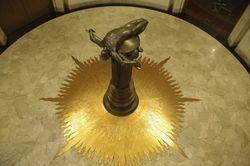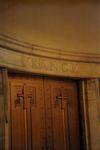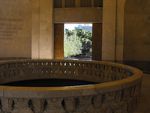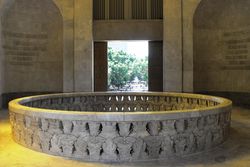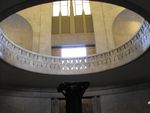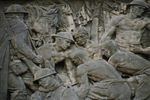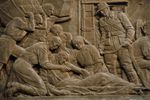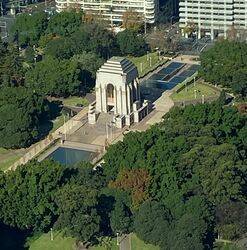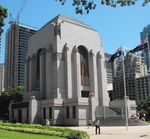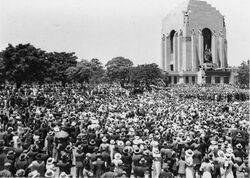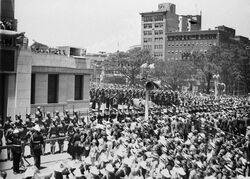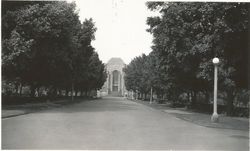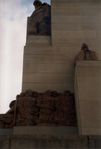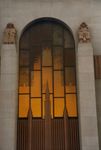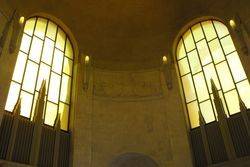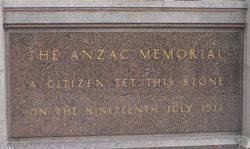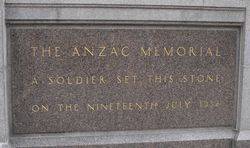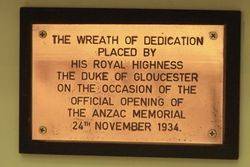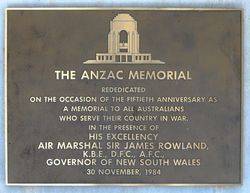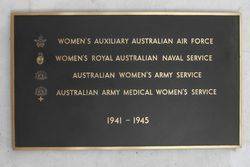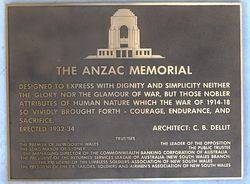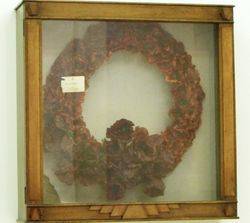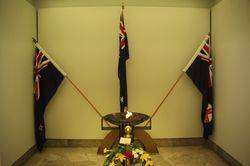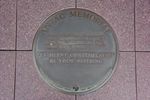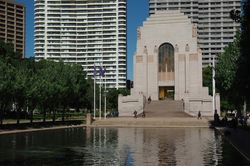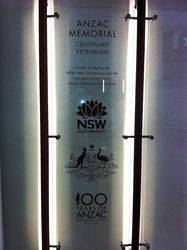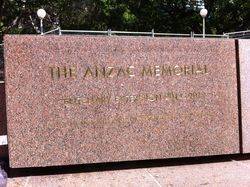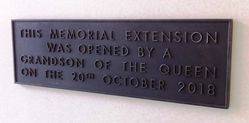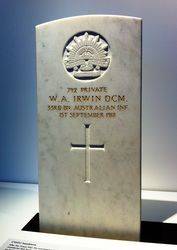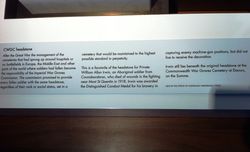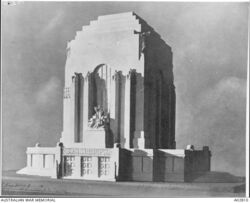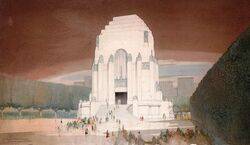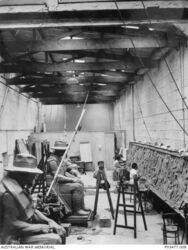
ANZAC MemorialPrint Page 
The ANZAC Memorial was completed in 1934 to commemorate the achievements of the Australian Imperial Force. The memorial was rededicated on its 50th anniversary in 1984 as a memorial to all Australians who serve their country in war. It has been declared a “Military Memorial of National Significance” under the Military Memorials of National Significance Act 2008.
The building, designed by C. Bruce Dellit, is a concrete structure clad in stone with sculptures by Raynor Hoff. Rayner Hoff was the major designer of the sculptures on this art deco monument of world significance. It is a superb example of the Art Deco style combined with fine sculpture in a large monument set atop a rise in Hyde Park.
Constructed of New South Wales red granite, sixteen great buttresses each topped by individual figures of men and women of the Australian Imperial Force surround the monument. Internally the great circular Hall of Memory is superimposed upon a Hall of Silence wherein is the central figure, a statue representing sacrifices. There are 120,000 stars on the domed ceiling which were sold during the Great Depression to members of the public for two shillings each in a massive fundraising effort to finish construction.
On 25 April 1916, the first anniversary of the landing of the Australians at ANZAC Cove, a fund was opened to raise money to erect a permanent war memorial in Sydney. By the end of the war the fund had reached 60,000 pounds.
In 2018, the ANZAC Memorial Centenary Extension was built which realises architect Bruce Dellit’s original concept for the memorial. Dellit had originally envisioned two water features running on a north-south axis to the Memorial, but due to the impact of the Great Depression only the Pool of Reflection north of the Memorial was ever built. A contemporary interpretation of the water cascade on the southern side of the Memorial, a symbol of hope for future generations, completes the original 1930s concept design. A walkway through the Cascade allows Memorial visitors to enter the new Hall of Service, exhibition galleries and education facilities.
The Hall of Service includes a major artwork by Fiona Hall featuring 1,701 soil samples from each New South Wales town, suburb and district given as the home address by World War One enlistees. This project was supported by hundreds of volunteers across New South Wales.
The Oculus, which is centred above the Hall of Service with a view out to the Memorial exterior, is an architectural reference to the Well of Contemplation in the existing Hall of Memory and visually connects the two. Beneath the Oculus lies soil collected (where possible) from 100 battle sites of significance to New South Wales military history set into a ring in the floor.
Architectural firm Johnson Pilton Walker designed the Centenary Extension in collaboration with the New South Wales Government Architect.
The official reopening was undertaken by His Royal Highness Prince Henry, the Duke of Sussex, on 20 October 2018.
The unveiling and dedication of the Anzac Memorial was one of the great events associated with the visit of His Royal Highness the Duke of Gloucester. When completed in every detail the memorial will have cost £80,000. Already £75,000 has been spent. The central motive of the memorial is a group of statuary symbolising sacrifice. Around this conception the whole memorial design has been developed. Internally, states the "Sydney Morning Herald," the memorial comprises a Hall of Silence, wherein is placed the sacrifice motive, and on the walls of which are inscribed those areas throughout the world in which the A.I.F. operated. On the threshold are the words, "Let Silent Contemplation be your Offering," the object being to give the shrine a quality of peace and sacred quiet. In keeping with this feeling of contemplative silence the interior lighting is diffused in a soft, amber glow through the windows of the memorial. Above the Hall of Silence is the great Hall of Memory, the dome of which—90 feet above ground level— is encrusted with a constellation of stars of memory, aggregating 120,000.
An interesting feature of the Hall of Memory is the entrance to the Archives Room. This is presented by a symbolism carved in marble, representing the Rising Sun of the A.I.F., carried on the wings of Time, bearing the flaming sword of War. This symbolism, when viewed from below in the Hall of Silence, points to the recumbent figure of Sacrifice. Externally the story of the war is told by the sculptured units placed in various positions around the Memorial itself. The four great figures near the apex represent the Army, the Navy, the Army Medical Corps, and the Air Force, and the seated figures superimposed upon the great buttresses represent the various units of those services.
Australasian (Melbourne), 8 December 1934.
Location
| Address: | Elizabeth Street, Hyde Park South, Sydney, 2000 |
|---|---|
| State: | NSW |
| Area: | AUS |
| GPS Coordinates: | Lat: -33.875697 Long: 151.2109 Note: GPS Coordinates are approximate. |
Details
| Monument Type: | Monument |
|---|---|
| Monument Theme: | Conflict |
| Sub-Theme: | Multiple |
| Designer: | C. Bruce Dellit |
| Artist: | Rayner Hoff |
| Monument Manufacturer: | Kell & Rigby (NSW) |
Dedication
| Actual Monument Dedication Date: | Saturday 24th November, 1934 |
|---|
ANZAC Memorial
This memorial is sacred to the memory of all who have served in war
Let silent contemplation be your offering



